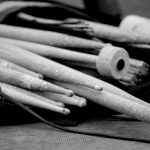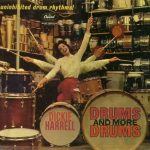Buying A Used Drum Set: The Short Guide
Posted in Learn | Last Updated on June 3, 2019

A used drum set can be perfect for those on a budget, or those looking to find a vintage drum sound that might not be in production anymore.
When buying used, it's really important that we know what we're looking for. Naturally, older drums are going to have some wear and tear. Some of that is going to be strictly cosmetic, but some wear and tear can affect the drums' sound and functionality (Cosmetic damage is mostly OK!).
I'm assuming looks don't mean that much to you if you're buying a used drum set (I know they are not very important to me!), so don't be turned off by scratches, stains, dirt, etc.
This article is divided into 4 sections...
- Looking For Vintage Drums?
- Your First Drum Set?
- What To Avoid/ Flaws To Look For
- Checking Your Used Hardware
Looking For That Vintage Sound?
This may not be your first drum set, but buying a used drum set is the only way to get your hands on out-of-production, vintage drums.
I will talk about what to avoid later on this page.
Ludwig, Gretsch, Slingerland, and a couple others all have a great reputation when it comes to vintage drums. Jazz drummers are very fond of old Gretch "Gretsch" drums. Old rockers might be found of the Slingerlands, Ludwigs or even Premiers.
In general, vintage drums will be a little expensive, simply because of their rarity. As a rule of thumb, the better shape they're in, the more they'll cost. 4-piece kits might set you back upwards of $1000. However, there are always exceptions.
Some people just don't know what they've got. Some amazing kits just sit in people's basements until they're eventually unloaded by their owners for virtually nothing. Amazon, Ebay and Craig's list are great for this, as most drum shops will know they have something great.
I've even found a vintage, Gretsch "roundbadge" snare drum for under $200 on eBay. It's one of the better drums I've ever played.
Your First Drum Set?
Is this your first kit? Buying used is a great way to save money. Plus, your options are going to be more numerous because, quite frankly, you don't need a top quality drum set.
I still wouldn't recommend going to the basement, though. The market (eBay, as well as drum shops) is flooded with very low-quality drums. Even brand new, these kits are cheaper than an average used 4-piece drum set from a trusted drum manufacturer. No-name brands like Mendini, Gammon, and Crescent (to name only 3) might only set you back $150-$200, but sound, feel, and functionality of the drums is so inferior that I must warn against it.
Even a beginner should start getting used to how properly crafted drums and skins sound and feel like.
For your first kit, I recommend finding a used drum set from one of the bigger, more trusted manufacturers:
- Yamaha
- Pearl
- Tama
- DW
- Sonor
- Remo
- Pork Pie
- Orange Country Percussion
- Gretsch
- Brady (custom drums, rare to find them cheap)
- Mapex
- Fibes
- CB
...To name only a few! With a little searching, you'll be able to find a simple, used kit from any of these drum makers that range anywhere from $300 to $700, depending on your budget.
If you're lucky, you can even find some vintage drums that might still sound awesome, at a very great price. Some brands to look for are:
- Ludwig
- Gretsch
- Slingerland
- Rogers
- Premier
...To name a few (again).
When choosing a used drum set, a name alone will not suffice. You must make sure that the drums are not in rough shape structurally. Here's what to avoid... (next section)
What To Avoid/ Flaws To Look For
When buying a used drum set, vintage or modern, there are some things that you can expect...
Dirt, grime, and scratches are just fine. Drums take a beating over several years of traveling and abuse. These things can be fixed/cleaned, but are not really important because they don't affect the sound, functionality or playability of the drum set (to any significant degree). Even broken heads are acceptable, they can easily be replaced.
Some problems that develop are a little more serious and could require extra investments up front to get the used drum set into playable condition. Here's what to look for:
- Are all the lugs, top, and bottom, tunable. That is to say: do they stick? Are they rusted and stuck? Heads cannot be properly installed if the lugs don't all work. Lugs are usually lubed/greased by the manufacturer to ensure lasting functionality. If the lugs work, but the drums are old, consider greasing them a little.
- Are the drums round? Some drums are "out of round", meaning they are slightly oval. I've made the mistake of buying mis-shapen drums, and it's not fun. Heads will not properly fit and will break very frequently if they don't sit properly along the rim. Try taking heads off the drums, and putting others on to see if the drum is round. It should be obvious to you if the drums are not in a good, circular shape.
- Are the bearing edges uniform? The edge of the shell that touches the head directly should be uniform all around. The bearing edge should touch the skin evenly in all places. Small nicks and gouges are not optimal, but will not render the drums un-playable. However, if larger portions of the edge do not touch the skin because they are not of equal height, the drums will need some work that could be costly.
- Does the snare drum throw-off switch work well? Sometimes you may need to adjust some screws to get the snare drum throw-off switch into the proper balance of slack/loose with the actual snare wires. But if upon attempted adjustment, the snare throw-off switch doesn't move, doesn't stay in the "on" position, or doesn't do its job properly in any way, you might want to reconsider!
- Does the bass drum hardware function properly? Make sure rack tom holders fit into the bass drum hole, and that they indeed support the toms' weight and can be adequately adjusted. Also, make sure the bass drum legs can support the bass drum in a reasonably straight/level orientation.
Apart from these drum related issues, you want to inspect hardware...
Checking Your Used Hardware
Most of the time, a used drum set comes with hardware. Make sure that these crucial pieces function properly:
- Is the hi-hat stand in good shape? Check the rod to make sure it's not too bent. The rod is what holds your cymbal to the rest of the stand, and if it's bent, it may hinder the lifting/dropping motion of the hi-hats. Make sure the pedal will push/pull the rod up and down without any resistance or squeaking from rust. If you buy it rusty, it will only get worse with time and wear.
- Do the cymbal stands hold up to any reasonable abuse? If they slip and don't hold up, or if screws cannot be tightened or loosened, they need to be replaced or repaired. Cymbals need to be at the right height for you, otherwise, you risk injury from playing incorrectly. Stands aren't too expensive, so this might not be a deal breaker.
- If the used drum set comes with a bass drum pedal, make sure the adjustable screws are indeed usable, and that the springs and beater all function properly. Some pedals are more adjustable than others, but as long as you can tighten the spring, and adjust the beater placement, you should be in good shape!
Again, the hardware is usually not a real deal breaker for me, as some kits don't even come with hardware. Cheap, dependable hardware is easy to find, and if you need to replace something, it's not going to cost you too much extra. Consider it a potential part of your initial investment.
Good luck hunting for a used drum set that suits your needs!




![10 Best Drum Practice Pads out of 23 Tested [Updated Buyer Guide]](http://cajonguide.com/wp-content/uploads/2018/03/best-drum-practice-pads-review-150x150.png)




